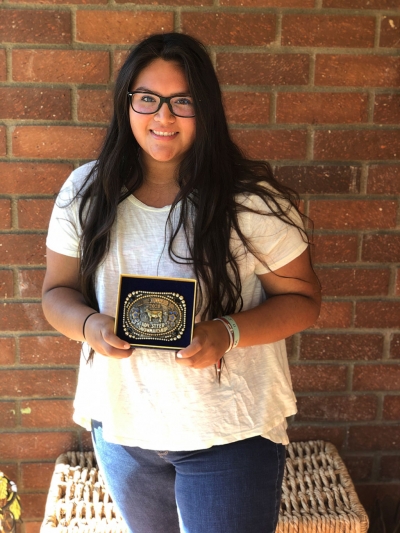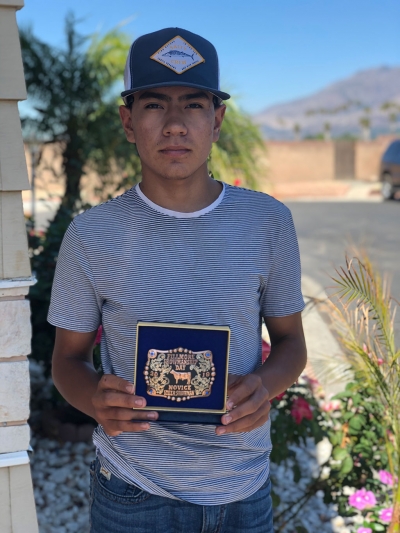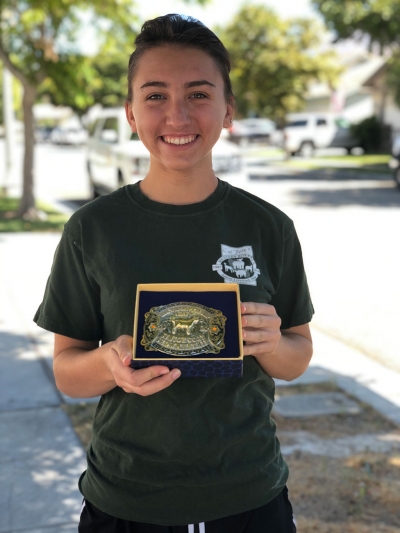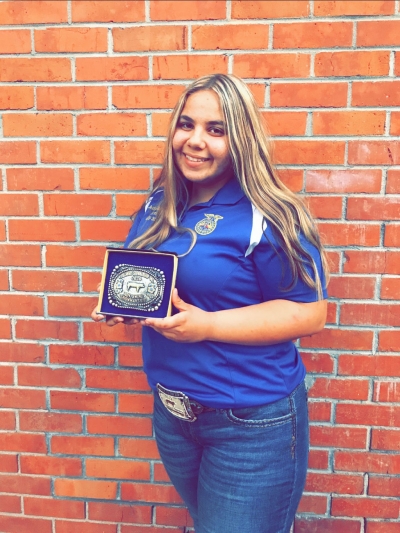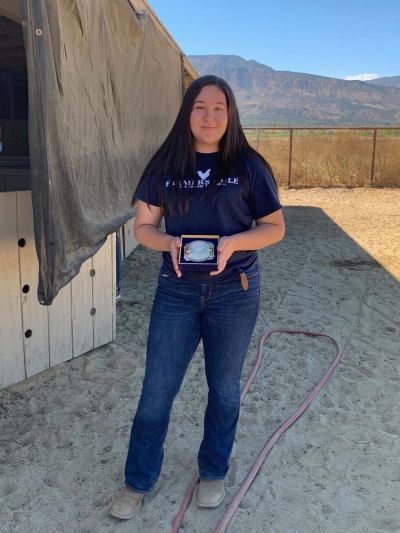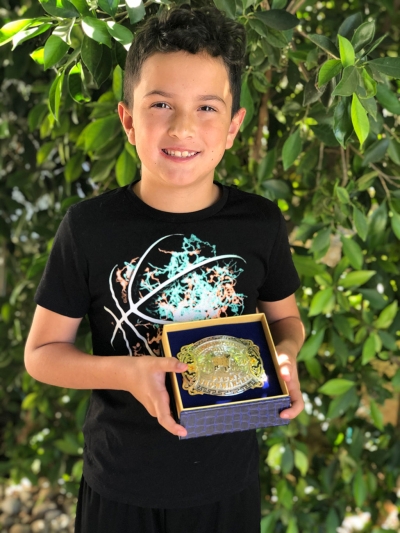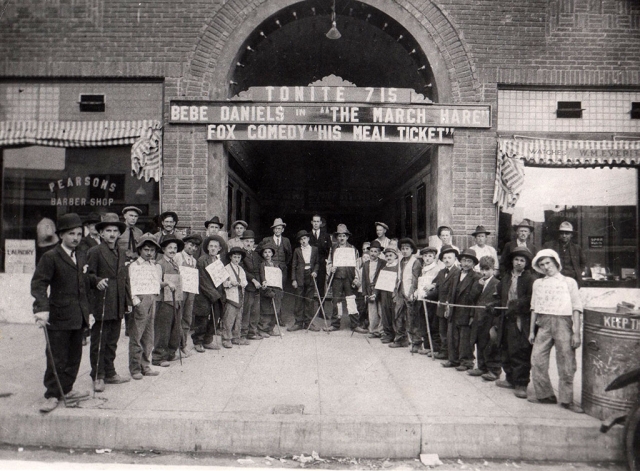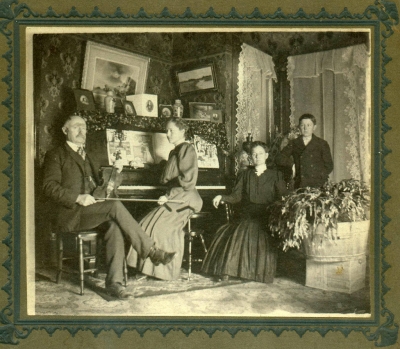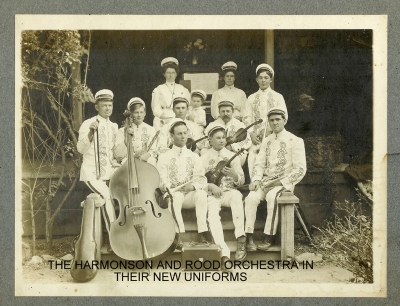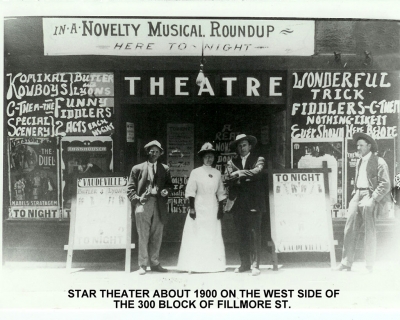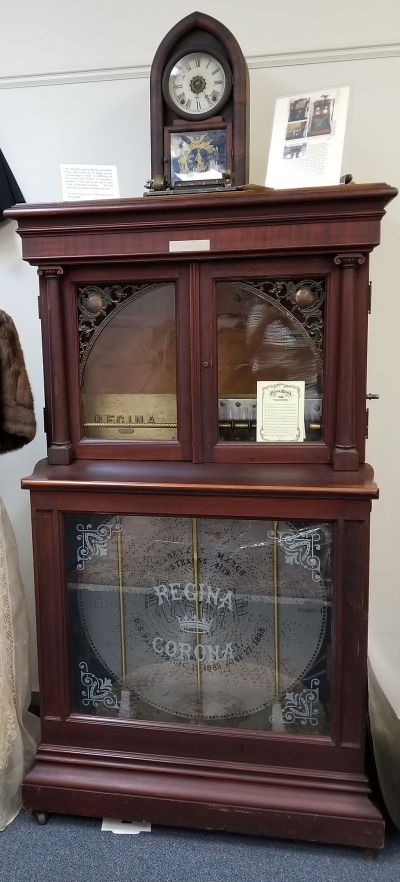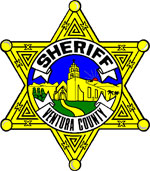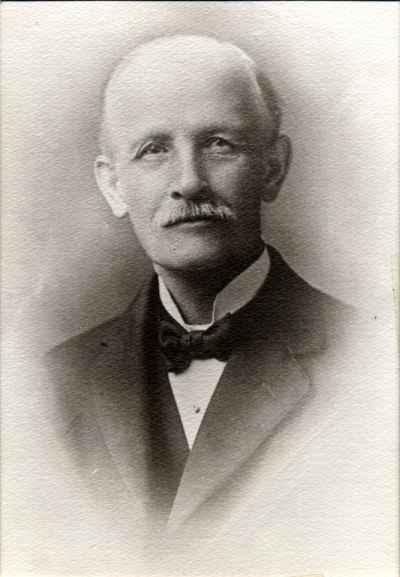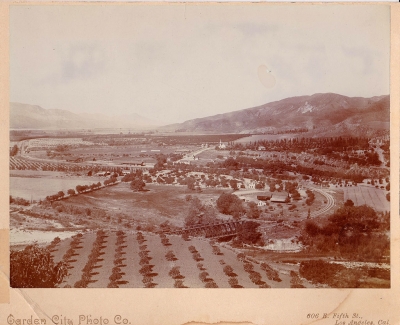|
By Anonymous — Wednesday, August 12th, 2020
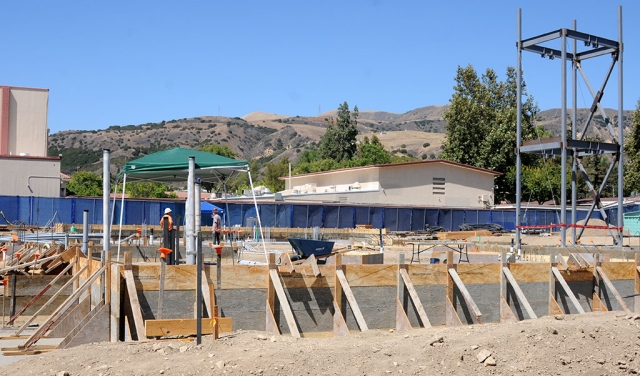 The Fillmore High School Career Technical Education Facility, Agricultural & Transportation SDSR (Systems Diagnostic Service and Repair) Pathway buildings are making progress despite the COVID-19 Pandemic. The project timeline is scheduled for summer 2019 to spring 2021 and is funded by the Measure V Bond and State CTE Funding. Enlarge Photo |
|
By Anonymous — Wednesday, August 12th, 2020
Submitted by Pam Klittich of Fillmore FFA On Friday, August 7th the Fillmore FFA hosted a virtual Showmanship Day. Due to COVID-19 restrictions instead of hosting the annual show live Ag teachers Veronica Lemus and Pam Klittich set up a website where local youth could virtually compete with their livestock animals in showmanship. The show was open to any FFA, 4-H, Grange, or Independent youth who lived within the Fillmore and Piru community. Competitors entered with videos of them and their livestock looking and acting their best. Videos were sent to outside judges in the livestock industry and were placed in their class. Many of the livestock will be sold on Saturday, August 15th in the 2020 Junior Livestock Virtual Auction hosted through 805agkids.com. Fillmore FFA strongly encourages anyone interested in buying, adding-on, or supporting these youth livestock projects to go to 805agkids.com and click on the BUY button. The results of the 2020 Fillmore FFA Showmanship day were as follows; Advanced Beef Showmanship: Champion Kayla Carrillo/Fillmore FFA, 2nd Juan Jimenez/Fillmore FFA, 3rd Michael Frost/Fillmore FFA. Novice Beef Showman: Champion Alex Avila/Fillmore FFA. Novice Lamb Showmanship: Champion Emma Ramos/ Fillmore FFA, 2nd Erika Luis/Fillmore FFA, 3rd Vicente Lopez/Fillmore FFA. Advanced Swine Showmanship: Champion Jordyn Blankenship/Fillmore FFA, 2nd Ryan Gonzalez/Fillmore FFA, 3rd Natalie Parrish/Fillmore FFA, 4th Paul Smith/Fillmore FFA, 5th Della Alamillo/Fillmore FFA. Junior Swine Showmanship: Champion Jessika Aguilar/Sespe 4-H, 2nd Miguel Rincon/Sespe 4-H, 3rd Gabriella Bingham/Bardsdale 4-H, 4th Zachariah Garcia/Sespe 4-H, 5th Mathew Zavala/Sespe 4-H. Novice Swine Showmanship: Champion Alanna Garcia/Fillmore FFA, 2nd Marcelo Perez/Simoore Grange, 3rd Maribel Ruiz/Simoor Grange, 4th Holly Parrish/Bardsdale 4-H, 5th Landyn Long/Simoore Grange. Advanced Goat Showmanship: Champion Brooke Allen/Sespe 4-H, 2nd Jashua Olivera/Bardsdale 4-H, 3rd Michael Olivera/Bardsdale 4-H. Junior Goat Showmanship: Champion Jennifer Olivera/Bardsdale 4-H. Novice Goat Showmanship: Champion Sophia Michel/Sespe 4-H, 2nd Bibiano Hernandez/Fillmore FFA, 3rd Gisel Arrendondo/Fillmore FFA, 4th Arianna Vargas/Sespe 4-H. Pygmy Goat Showmanship: Champion Ethan Zavala/Sespe 4-H, 2nd Isabella Zavala/Sespe 4-H, 3rd Mathew Zavala/Sespe 4-H. |
|
By Anonymous — Wednesday, August 12th, 2020
Courtesy of Fillmore Historical Museum Did you ever wonder why so many of the old photos showed mom, dad and a couple of children in their simple living room gathered around the piano, daughter playing the piano, dad playing a violin and the rest singing or just enjoying the music? In those days entertainment was a do it yourself project. Playing the piano was almost a required skill. There was no TV, no radio. Fillmore didn’t even have electricity until 1907 when electric lights came to Central Ave. and were installed between Richard Stephens’ store on the southwest corner and Harmonson and Rood store on the south east corner of Central. So, in the evening families and friends gathered around the piano and entertained themselves. The violin or fiddle as it was often called was also popular. It was transportable. Having a party? Invite someone who could play the fiddle and dancing ensued. Taking a long trip such as a wagon train west, don’t forget the fiddle. One of the earliest entertainment venues here was the Bardsdale Social Hall on Ventura St. just north of the Methodist church in Bardsdale south of the Santa Clara River. Saturday nights in 1893 found the oil crews down from the hills and ready to party. There was a small band, the Harmonson and Rood band, and, of course, dancing. It went very well for a time until the local minister up the street decided to have a visiting preacher for a revival meeting. When the preacher, a woman, found out that that wonderful band that entertained in her revival meeting had the night before entertained the partiers down the street she put up such a fuss that the local minister never again could have that band play for church. Too bad because the band was good and had played for free. In 1894 Richard Stephens repurposed a packinghouse north of a vacant lot on Central Ave. and Main St. for a theater which he called naturally, “Stephens Hall”. Stephens used packing boxes left from the packinghouse for seats and built a 3 foot stage in one corner. A variety of traveling shows performed in the Hall. These included minstrel shows, a traveling hypnotist, Pavilla Comedy Company and, for the teenagers of the time, social dances by printed invitations to “Yourself and Your Lady”. He eventually built a store on the lot south of the theater. Today it is the location of La Estrella market. You can still see his name in the tiles at the front entrance of the store on Main St. The theater is long gone but can be seen in old photos of Central Ave. The first real theater built in town was the Star Theater. It was built by Wilmer Akers in about 1900 in the 300 block of Fillmore St. It was a vaudeville house and silent movie palace. In 1902 Akers purchased a giant music box which played a 27” disc. That music box is still playing and can be heard at the Fillmore Historical Museum. By the teens, Fillmore was awash in entertainment not all of it welcomed. The Fillmore Herald in September, 1913, noted that The California Carnival Company was headed for town. They had visited Fillmore twice before and had apparently found the locals “easy pickins”. The sheriff and the city fathers called the carnival “loathsome” and they were told in no uncertain terms to find some other place to go. They were advertising something called “Barbary Coast Attractions.” One can only imagine! According to an early story by museum founder, Edith Jarrett, Medicine Shows often set up for business on Main St. near Central Ave. One in 1909 displayed pickled tapeworms, roundworms, and unidentifiable pieces of anatomy making the audience queasily in need of his medication. The barker, dressed in a gaudy velvet vest, sold pain killers and a variety of cure-alls. The “doctor” entertained by playing a banjo, tossing out silver dollars and when the audience was completely taken in by the show, began to curetoothaches or other pains by using a little of his magic medicine. By the time he was finished he had sold out of wares, mostly laudanum in a syrup, and was ready to quickly move on to another town. There was also less formal entertainment. Fishing, hiking, swimming and hunting were popular. There were two “pool halls”. Church activities kept bored youngsters from getting into trouble. Although with all the work kids did in those days on the farm, being bored was not generally a childhood problem. In 1911, Merton Barnes came to Fillmore and leased the new Brinley building on the North West end of Central and Sespe. His “Empire” theater had a sloping floor and a screen. He hand lettered glass plates for a fee for local businesses and showed them on the screen using a “magic lantern”. (Advertising obviously has been around since the beginning of entertainment.)Vaudeville was the popular entertainment of the day with comedy, singing and dancing acts. But Barnes also showed the latest craze, motion pictures. The serial, “The Perils of Pauline” was shown in 1914. He also booked William S. Hart movies. (Many of you may remember the theater in the 1940s and 50s, known then as The Palm Theater.) Barnes moved across the street in 1917 when he built the Barnes Theater on a lot which had been the location of Leon Hammond’s home. The theater had 500 seats and was state of the art with a stage door at the back for scenery, a trapdoor in the stage floor,and an orchestra pit. In addition to silent movies, it was used for musical recitals and vaudeville road shows. One of the major events at the theater in 1919 was a Charlie Chaplin lookalike contest. Boys dressed up like Charlie Chaplin complete with moustaches, hats and canes. Gerald “Sadie” Davis won the contest and received $1.00 Ingersoll watch. Today the theater is vacant waiting for some creative individual to find a new use for it. So the next time you are bored and in need of entertainment, look beyond the internet, cable or TV and remember how for most of history people entertained themselves and had a wonderful time doing it. |
|
By Anonymous — Wednesday, August 12th, 2020
Chumash tribes, local businesses, organizations, and elected officials join thousands of community members speaking out for Pine Mountain Ridge
Opposition builds at the approach of the August 14 deadline for the public to comment on the Forest Service’s proposal to log trees and grind up chaparral along six miles of the prominent ridge known as Pine Mountain, deep in the Ventura County backcountry. Local tribal groups, businesses, elected representatives, and members of the public, from Ventura, Santa Barbara, and San Luis Obispo counties, and beyond, have submitted well over 10,000 comments to the Forest Service opposing its proposal to remove old-growth trees and chaparral across 755 acres—the equivalent of 575 American football fields—without an environmental assessment. The project, located in some of the most diverse and unique habitats in the region, has received many times more comments than any single project proposed in the Los Padres National Forest. Concerns include the avoidance of appropriate environmental study and examination of alternatives normally required for such projects under the National Environmental Policy Act (NEPA), disturbance of cultural sites, damage caused to a much-loved recreation area, impacts to sensitive plant and animal species, increased wildfire risks, weakening of the forest’s ability to adapt to climate change, and the possibility that the project will be conducted by a commercial logging company. Signatures continue to be collected on a letter, already signed by over 30 area businesses including Patagonia, Toad & Co., outfitters, wineries, and breweries, that opposes the project based on the benefits that Pine Mountain ridge provide to the region’s economy and quality of life. Nearly 70 environmental and social justice organizations have signed onto a separate letter challenging the Forest Service’s lack of collaboration and the skirting of NEPA studies. The letter also questions the efficacy of remote vegetation clearing to protect distant communities from wildfire. “Our primary concern is the project’s lack of attention and near total insensitivity to the potential impact to Chumash cultural values and resources,” wrote Julie Tumamait-Stenslie, Chair of the Barbareno/Ventura Band of Mission Indians. Chumash tribes including the Barbareño/Ventureño Band of Mission Indians and Coastal Band of the Chumash Nation, and elected officials including Congressmembers Julia Brownley and Salud Carbajal, Ventura County Supervisors Linda Parks and Steve Bennett, and Ojai mayor John Johnston have submitted letters to the Forest Service also calling for further environmental review and public engagement. “I understand, the U.S. Forest Service’s own assessment of potential and existing fuel breaks in the southern Los Padres National Forest ranks this project as 118 out of 163 in terms of priority. Given the project’s low priority, it is unclear to me why this project has been selected to bypass complete environmental analysis,” said Representative Brownley of California’s 24th Congressional District, where thousands of Pine Mountain advocates live. Despite its massive scale, the Forest Service intends to fast-track the project by categorizing it as “forest health and fuels reduction” to bypass requirements under the NEPA to conduct a detailed study of potential impacts on the area’s unique ecosystems, as well as to consider alternatives that may be more effective and less harmful. The agency has admitted that the project will do little to aid in fighting the type of fires that cause the vast majority of damage to communities each year. Further, vegetation removal projects can increase wildfire risk by removing fire-resistant trees, increasing heating and drying of the forest floor, and spreading non-native invasive grasses and weeds that ignite more easily and spread wildfire more quickly. “The City of Ojai would recommend promoting defensible space requirements near homes rather than logging special and invaluable old growth forests of Pine Mountain,” stated a letter signed by Mayor Johnston Over one-third of the project area is proposed for wilderness protection under the Central Coast Heritage Protection Act (H.R. 2199), approved in a bipartisan vote by the House of Representatives on February 12, 2020 and which waits approval in the Senate, and further included in the National Defense Authorization Act which will go to conference committee between the two houses in the coming weeks. “Much of the project area is in its natural state, evolved over time without the disturbance of heavy modern machinery. Once trees are cut and the landscape is scarred by a project like this, the wilderness quality of the place is ruined,” said ForestWatch advocacy director Rebecca August. “We hope that those who have not yet spoken make their voices heard before it’s too late.” The Forest Service will accept comments on the project until August 14. This may be the only opportunity the public will have to weigh in with concerns. To submit a comment online or learn more about the project, visit ProtectPineMountain.org |
|
By Anonymous — Thursday, August 6th, 2020
Dear Fillmore Community, it is with a heavy heart that we announce the passing of our Bill Edmonds. To honor his life and legacy, we are inviting you to our home at 248 4th St. this Sat, Aug 8th between the hours of 8am to 11am to drive thru/walk up and contribute to a remembrance table that'll be set up in our front yard. You're welcome to bring a note or item that you associate with Bill. We'd appreciate if you added a brief message with your item that explains its significance. If you'd like to keep your thoughts associated with your remembrance private, please write "private" on you item or note. If you'd like the item returned please put a sticker or masking tape with your name and the word "return" on it. We will be making a short video to share with you about the remembrance items. Please leave us your email when you come so we can share the link. We look forward to seeing you. Thank you for having a special place in Bill's big heart. He truly loved his family, friends, and his community. With gratitude, Lynn and family. In lieu of flowers, please consider making a donation to One Step a La Vez (PO Box 192 Fillmore, CA 93016) or to the Fillmore Lions Club Scholarship Fund. |
|
By Ventura County Sheriff Department — Wednesday, August 5th, 2020
On July 21st 2020, the Sheriff’s Pharmaceutical Crimes Unit detectives concluded an investigation into known Fillmore gang-member Martin Quezada who was suspected of drug sales. Quezada is a convicted felon which makes him prohibited from possessing ammunition or firearms. Quezada is currently on Post Release Offender Supervision and considered a Serious Habitual Offender. Quezada was arrested and booked at the Ventura County Sheriff’s Main Jail for 487(d) PCGrand Theft Auto, 32310 PC- Possession of Large Capacity Magazine, 30305(a)(1) PCProhibited Person in Possession of Ammunition, 11351 HS- Possession for Sales of Controlled Substance, 11378 HS- Possession for Sales of Controlled Substance. Quezada remains in custody with bail set at $50,000. Prepared by: Detective Jonathan James Ventura County Crime Stoppers will pay up to $1,000 reward for information, which leads to the arrest and criminal complaint against the person(s) responsible for this crime. The caller may remain anonymous. The call is not recorded. Call Crime Stoppers at 800-222-TIPS (8477). |
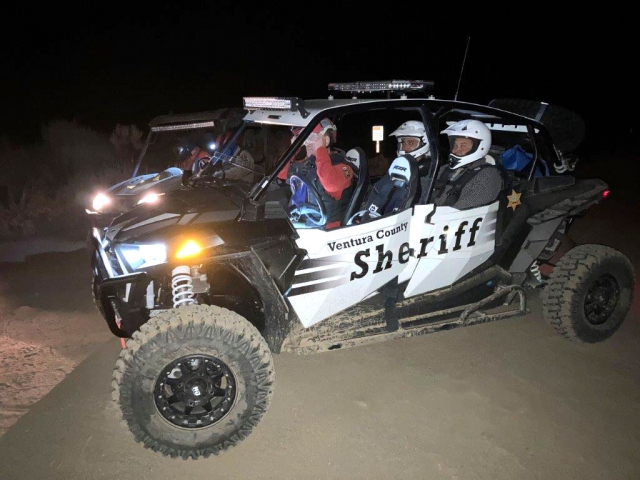 The Polaris RZR four-seat utility-task vehicle (UTV) that was used to help with a rescue at Sunset Campground on July 30th. Photo courtesy Ventura County Sheriffs Department. Enlarge Photo By Ventura County Sheriff Department — Wednesday, August 5th, 2020
On Thursday, 7/30/2020, at about 11:24 PM, the Ventura County Sheriff’s Office received a call for service reference stranded motorists on the off-highway vehicle trails near Sunset Campground. Sunset Campground is a remote campground in northern Ventura County accessible by experienced dirt bike riders and 4x4 vehicles equipped with significant clearance and appropriate tires. The stranded motorists’ reported that they had driven the Lockwood Creek Trail to the Miller Jeep Trail before their vehicle was rendered inoperable by several flat tires. Due to the remote area, the motorists’ did not have cellular telephone service and had to hike to find cellular service to call for assistance. The Fillmore Search and Rescue (SAR) Team, which is comprised of highly trained volunteers, was activated and responded to Lockwood Valley. They responded to the Sunset Campground along with a deputy from the Lockwood Valley Sheriff’s Station with numerous all-terrain vehicles to assist in the search. The Lockwood Valley Sheriff’s Station is outfitted with a Polaris RZR four-seat utility-task vehicle (UTV) that is available for these type of rescues. The deputy utilized the Sheriff’s RZR to drive to Sunset Campground through very rough terrain. At about 03:30 AM, the SAR team members and the Lockwood Valley deputy located the stranded motorists who were all in good health and were driven out of the area. This successful rescue operation was due to the efforts of the SAR team members and Lockwood Sheriff Deputy who utilized the specialized equipment, their training, and knowledge of the area to locate the motorists. The Sheriff’s Office would like to remind everyone that when they are recreating in the national forest and wildlands, it is imperative that it is done so safely and responsibly. Many of the hazards and risks associated with Off-Highway Vehicle recreation in these remote areas can be mitigated by proper planning and preparation. At a minimum, it is imperative to be familiar with the area you are recreating in, have a map, know the limitations of your vehicle and driving ability, have sufficient food and water, and ensure someone who is not with the group knows the details of your trip and when to report you as overdue. Please recreate responsibly for your safety and the safety of our first responders. Incident Number: 20-104338 |
|
By Anonymous — Wednesday, August 5th, 2020
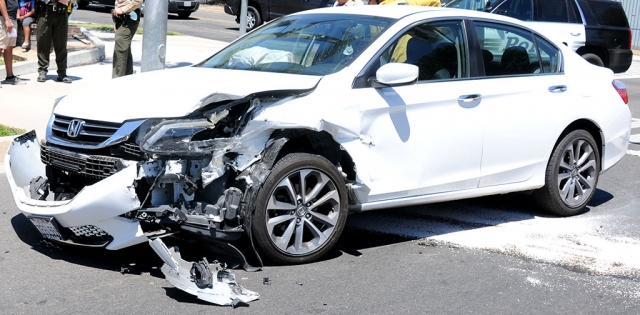 On Saturday, August 1st at 1:30pm at the corner of Ventura and B Street, a 2-car collision occurred between a white Honda Accord and a red Honda. One woman was checked at the scene for unspecified injuries. No further details were available at press time; cause of the crash is still under investigation. Enlarge Photo |
|
By Anonymous — Wednesday, August 5th, 2020
 In order to keep with state guidelines, and for customers to maintain their social distance of six feet apart, Vons has widened their aisles. Enlarge Photo |
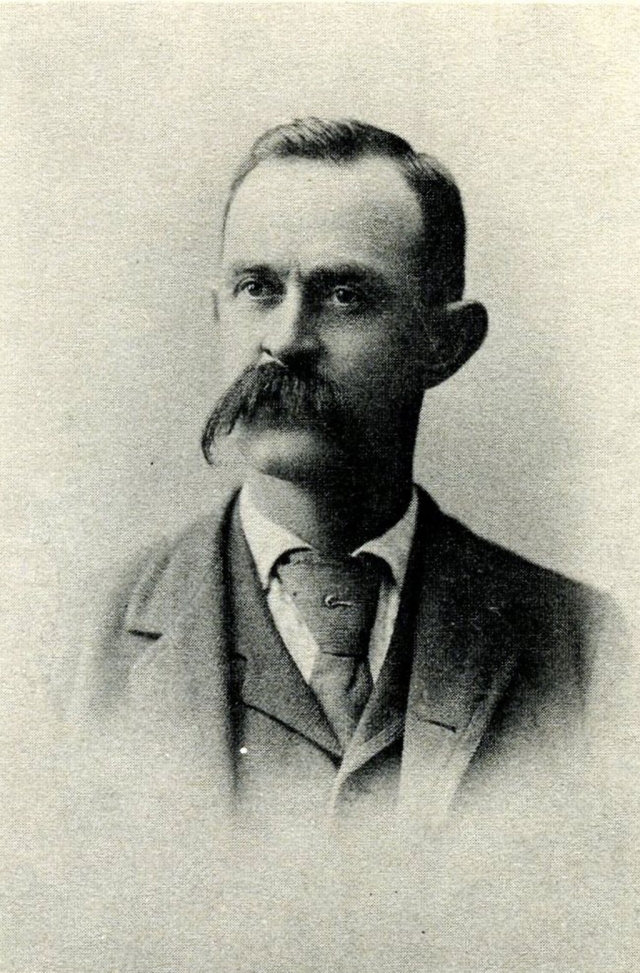 Hugh Warring, who moved to Piru in 1869. According to an interview in 1930, the Warrings became the owners of the Buckhorn Ranch. Photos courtesy Fillmore Historical Museum. Enlarge Photo By Anonymous — Wednesday, August 5th, 2020
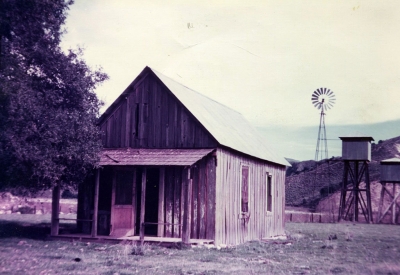 Before the town of Piru was developed, ranchers of the community built a school at Temescal in 1880. The school is now covered by Lake Piru. Enlarge Photo Courtesy Fillmore Historical Museum "The Fillmore Historical Museum would like to broaden it's archives on Piru. If you have any documents, family histories, or pictures you would like to share, please contact us at fillmore.museum@gmail.com." An Incomplete History of Early Piru The area we know as Piru has long been inhabited, first by the indigenous Chumash and later by European settlers. The purists agree that the correct pronunciation based on the Chumash name is Pee-Ru, not as it is now generally pronounced, Pye-Ru. It seems like this has been a controversy for decades as the July 24, 1930 Piru News captioned a story, “Piruveans want Contest with Owensmouth on Sunday,” regarding an anticipated baseball game. That name goes with Fillmoreans. The first Europeans to see this valley were Spanish soldiers with the Gaspar de Portolá expedition of 1769, who found a Chumash community at present day Piru. The land was initially under the administration of the Mission system, but after Mexican independence, the land was apportioned out as ranchos to those favored by the Mexican government. The area around Piru was granted to the del Valle family who founded Rancho Camulos. From Rancho Camulos, families such as the Sequieros and Salazars moved into the surrounding area. After it came under United States rule, others soon came into the area such as the Warrings, Hoppers and Whittakers. Many who came from Indiana and Pennsylvania were miners. They were following the stories of rich mineral deposits in the mountains around Piru as early as 1842. The “gold” that would make the valley prosperous would eventually be the citrus industry. The Warring family came to the Piru area in 1869 from San Jose. They were encouraged to move to the area by a brother-in-law, Ari Hopper, who already was living in the area. According to an interview with Hugh Warring in 1930, they came to own the Buckhorn ranch because the original owner, a man named Hitchcock, admired a revolver Hugh’s father, Benjamin, owned. Mr. Hitchcock got the revolver in exchange for the Buckhorn Ranch. The Ranch got its name from all the racks of deer horns that were displayed. The Ranch became a stopping place for travelers who gave the Ranch its name. Before the development of the town of Piru, the ranchers in the community built a school at Temescal. It was built around 1880 by Ben Reasoner and Henry Dunton. The site of the school is now covered by Lake Piru. In 1881, Reginald del Valle of Ranch Camulos ran for Congress against Col Henry Harrison Markham, who was backed by the powerful Southern Pacific. Not surprisingly del Valle lost the election and found himself in debt. To clear his debts, he sold the Temescal Land Grant in 1887 to David Cook of Chicago. Cook was a wealthy publisher of religious tracts who, like so many Easterners, chose to come to California to improve his ill health. Cook came to the Santa Clara River Valley with the intention of creating a “Second Eden”. Land was planted with crops and olive groves from the Old Testament. Purchasers of the land had to agree to various lifestyles such as not smoking and temperance. The story is told that one potential resident, R. A. Fremlin, was told “better not let Cook see that cigar in your pocket,” to which he is said to have replied, “I’m not going to sneak around for a smoke.” He moved on and settled in Bardsdale. With his plan for a Biblical paradise made, he laid out a city plan and promoted the new settlement. Work began in 1887 and continued energetically through 1888. Originally the town was to be sited on the south side of the mouth of the river in the Piru Canyon, but the Southern Pacific Railroad refused to run a spur up Piru Canyon. Cook changed the location to the current location. Because the Southern Pacific already had a depot at Rancho Camulos, they refused to build another at Piru. Cook built one at his own cost and paid the salary of the agent. During the winter of 1887-8 a Methodist-Episcopal Church was erected. This was not the church that stands today but a wood structure that also served as a school. In 1890 the existing building was built and served as a social center of the town as well the Church for decades. In June 1888, the post office was opened, with G.R. Walden as postmaster, succeeded in a few months by R. Sampson. C.J. French, who arrived May 29, was appointed assistant postmaster. In the meantime, a general merchandise store had been opened, and in September 1889 was sold to James Parsons and C.J. French, who did business under the firm name of C.J. French Co. Other businesses soon followed. What is now known as the Piru Mansion, was built by Mr. Cook about 1890. It went through several owners until the Newhalls purchased it. In 1981 they were in the process of restoring when a fire broke out, almost totally destroying the structure. The Newhalls undertook the challenge of again restoring the building. The community prospered and Mr. Cook’s health improved. Cook sold out to the Piru Oil and Land Company in 1900 after being cured of his ailments and realizing a profit due to recent oil discoveries. He left behind a growing community. |


